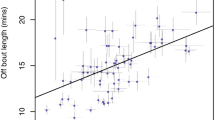Abstract
Timing of diapause termination has an important influence on individual reproductive success, but relatively little research has explored how individuals differ in their response to diapause termination cues. We tested individual variation in the timing of post-diapause activity in Polistes dominulus paper wasps. Wasps were overwintered in a temperature-controlled chamber. In the spring, ambient temperature was gradually increased and the time each foundress became active was recorded. Timing of post-diapause activity was most strongly associated with the facial patterns that function as a conventional signal of quality. Foundresses with facial patterns indicating high quality became active at lower temperatures than individuals with facial patterns indicating low quality. Early diapause termination is associated with dominance, so the relationship between diapause termination and facial patterns provides a mechanism linking facial patterns with dominance. Body weight and mating status did not influence timing of post-diapause activity. Juvenile hormone (JH) titer at the time of diapause termination was also measured in a subset of foundresses. There was no JH titer threshold for diapause termination. Instead, our results suggest that individuals may have different threshold responses to JH, as individuals that became active at a lower temperature had lower JH titers than individuals that became active at a higher temperature. Overall, there is substantial individual variation in response to diapause termination cues and the variation is likely to have important impacts on the fitness of nest-founding females.


Similar content being viewed by others
References
Denlinger D.L. 2002. Regulation of diapause. Annu. Rev. Entomol. 47: 93-122
Flatt T. and Kawecki T.J. 2007. Juvenile hormone as a regulator of the trade-off between reproduction and life span in Drosophila melanogaster. Evolution 61: 1980-1991
Green J.P. and Field J. 2011. Interpopulation variation in status signalling in the paper wasp Polistes dominulus. Anim. Behav. 81: 205-209
Huang Z.Y. and Robinson G.E. 1996. Regulation of honey bee division of labor by colony age demography. Behav. Ecol. Sociobiol. 39: 147-158
Huang Z.Y., Robinson G.E. and Borst D.W. 1994. Physiological correlates of division-of-labor among similarly aged honey bees. J. Comp. Physiol. A 174: 731-739
Jassim O., Huang Z.Y. and Robinson G.E. 2000. Juvenile hormone profiles of worker honey bees, Apis mellifera, during normal and accelerated behavioural development. J. Insect Physiol. 46: 243-249
Kostal V. 2006. Eco-physiological phases of insect diapause. J. Insect Physiol. 52: 113-127
Pardi L. 1948. Dominance order in Polistes wasps. Physiol. Zool. 21: 1-13
Röseler P.F. 1991. Reproductive competition during colony establishment. In: The Social Biology of Wasps (Ross K.G. and Matthews R.W., Eds). Comstock publishing associates, London, pp 309-335
Röseler P.F., Röseler I. and Strambi A. 1985. Role of ovaries and ecdysteroids in dominance hierarchy establishment among foundresses of the primitively social wasp, Polistes gallicus. Behav. Ecol. Sociobiol. 18: 9-13
Röseler P.F., Röseler I., Strambi A. and Augier R. 1984. Influence of insect hormones on the establishment of dominance hierarchies among foundresses of the paper wasp Polistes gallicus. Behav. Ecol. Sociobiol. 15: 133-142
Seppa P., Queller D.C. and Strassmann J.E. 2002. Reproduction in foundress associations of the social wasp, Polistes carolina: conventions, competition, and skew. Behav. Ecol. 13: 531-542
Starks P.T. 1998. A novel ‘sit and wait’ reproductive strategy in social wasps. Proc. R. Soc. B 265: 1407-1410
Starks P.T. 2001. Alternative reproductive tactics in the paper wasp Polistes dominulus with specific focus on the sit-and-wait tactic. Ann. Zool. Fen. 38: 189-199
Tauber M.J. and Tauber C.A. 1976. Insect seasonality - Diapause maintenance, termination, and postdiapause development. Annu. Rev. Entomol. 21: 81-107
Tibbetts E.A. 2006. Badges of status in worker and gyne Polistes dominulus wasps. Ann. Zool. Fenn. 43: 575-582
Tibbetts E.A. 2010. The condition-dependence and heritability of signaling and non-signaling color traits in paper wasps. Am. Nat. 175: 495-503
Tibbetts E.A. and Banan M. 2010. Advertised quality, caste and food availability influence the survival cost of juvenile hormone in paper wasps. Proc. R. Soc. B 277: 3461-3467
Tibbetts E.A. and Curtis T.R. 2007. Rearing conditions influence quality signals but not individual identity signals in Polistes wasps. Behav. Ecol. 18: 602-607
Tibbetts E.A. and Dale J. 2004. A socially enforced signal of quality in a paper wasp. Nature 432: 218-222
Tibbetts E.A. and Izzo M. 2009. Endocrine mediated phenotypic plasticity: condition-dependent effects of juvenile hormone on dominance and fertility of wasp queens. Horm. Behav. 56: 527-531
Tibbetts E.A., Izzo M. and Huang Z.Y. 2011. Behavioral and physiological correlates of juvenile hormone titer in Polistes dominulus wasp foundresses. Behav. Ecol. Sociobiol. 65: 1123-1131
Tibbetts E.A. and Lindsay R. 2008. Visual signals of status and rival assessment in Polistes dominulus paper wasps. Biol. Lett. 4: 237-239
Tibbetts E.A., Mettler A. and Levey S. 2010. Mutual assessment via visual status signals in Polistes dominulus wasps. Biol. Lett. 6: 10-13
Tibbetts E.A. and Shorter J.R. 2009. How do fighting ability and nest value influence usurpation contests in Polistes wasps? Behav. Ecol. Sociobiol. 63: 1377-1385
West-Eberhard M. 1969. The social biology of polistine wasps. Misc. Publ. Mus. Zool. UM 140: 1-101
Zanette L. and Field J. 2009. Cues, concessions and inheritance: dominance hierarchies in the paper wasp Polistes dominulus. Behav. Ecol. 20: 773-780
Acknowledgments
Thanks to David Borst for generously providing the antiserum and to S. Levey for research assistance. Funding was provided by the University of Michigan.
Author information
Authors and Affiliations
Corresponding author
Rights and permissions
About this article
Cite this article
Tibbetts, E.A., Izzo, A. & Tinghitella, R.M. Juvenile hormone titer and advertised quality are associated with timing of early spring activity in Polistes dominulus foundresses. Insect. Soc. 58, 473–478 (2011). https://doi.org/10.1007/s00040-011-0166-x
Received:
Revised:
Accepted:
Published:
Issue Date:
DOI: https://doi.org/10.1007/s00040-011-0166-x




